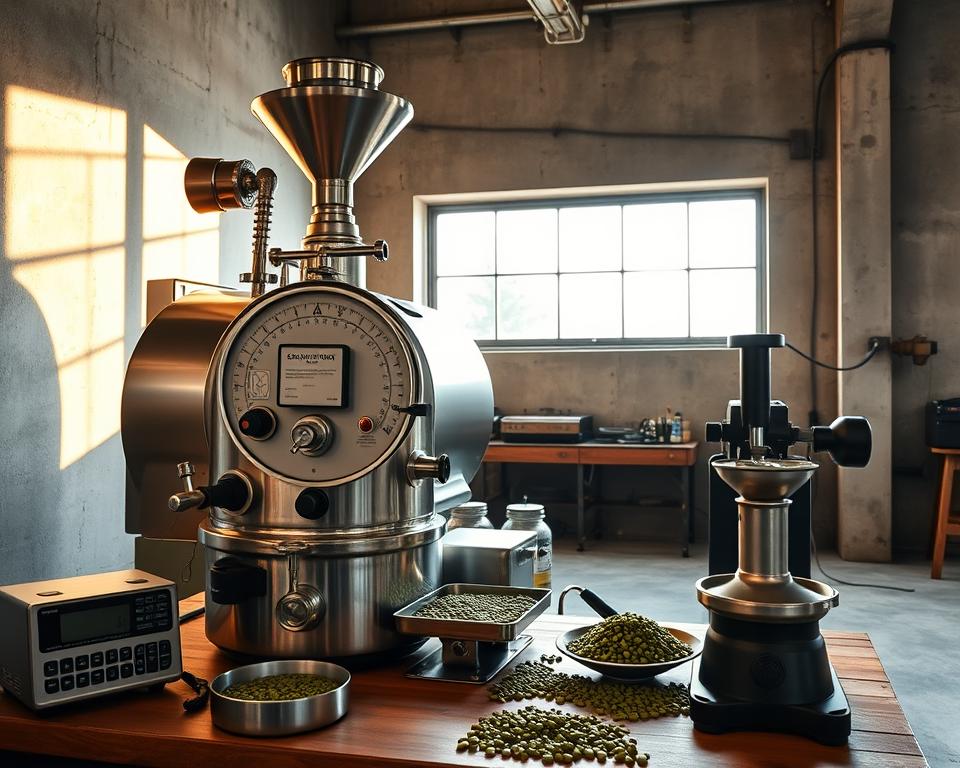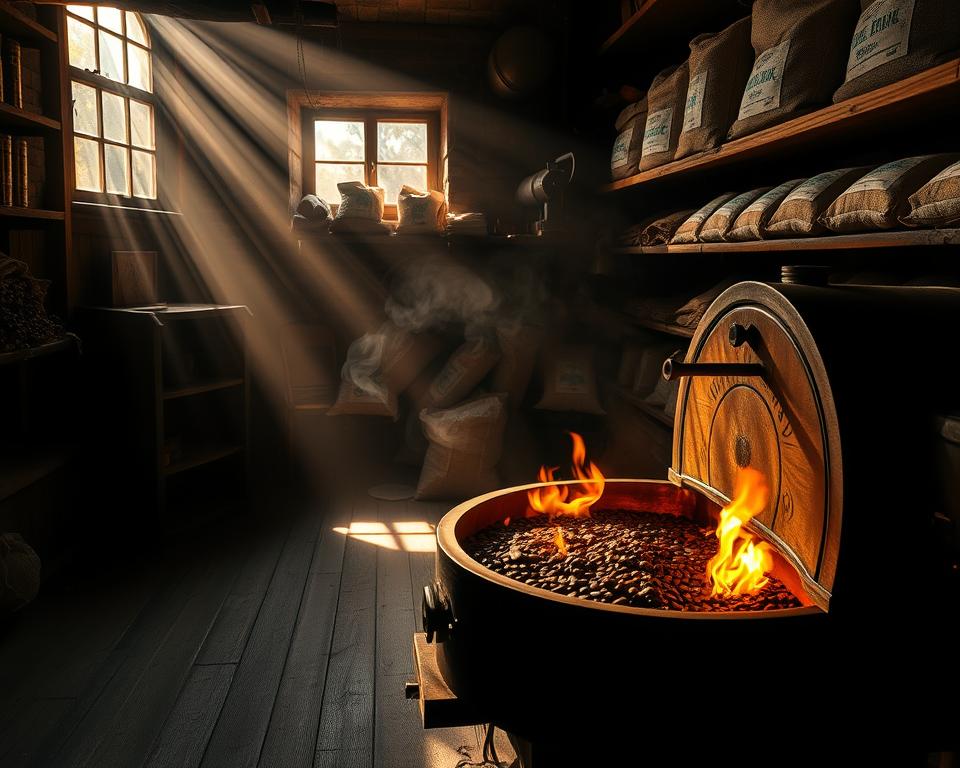Coffee roasting’s history is rich and varied, evolving from ancient open flames to cutting-edge technologies. For centuries, traditional methods like open-fire roasting have deeply influenced cultures. Today, 25% of artisan producers continue these ancient practices. On the other hand, modern techniques such as drum roasting now dominate 60% of the market, offering a balance between efficiency and flavor.
The journey from Ethiopia’s 6th-century origins to the Sarawat Mountains’ historic roasting practices is fascinating. Each step transformed raw beans into the complex brew we enjoy today. This evolution showcases the profound impact of coffee roasting on our culture and taste preferences.
Recent innovations, such as infrared roasting, have significantly reduced roasting times by 30%. This highlights the remarkable progress made in the industry. The 20% annual growth in specialty coffee underscores a global trend towards precision and quality. Brands like Latitude 23.5 Coffee & Tea are leading this charge with AI-driven technology for consistent roasts.
This transformation from clay pots to digital sensors underscores the importance of coffee roasting techniques. They play a crucial role in shaping the flavors we experience in every sip. This journey from traditional to modern methods is a testament to human ingenuity and our relentless pursuit of perfection.
Key Takeaways
- Coffee roasting began in Ethiopia and spread across Arabia by the 15th century.
- Modern drum roasting powers 60% of commercial operations today.
- Traditional methods vary flavors by 40%, while modern tech reduces variance to 5%.
- Specialty coffee’s 20% yearly growth reflects demand for precise roasting techniques.
- AI and data-driven methods now drive sustainability and efficiency in the industry.
The Origins of Coffee Roasting
The tale of Coffee Roasting starts in ancient Ethiopia, where coffee cherries were first noted for their energizing effects. Early communities, over open fires, found that heating green beans released rich flavors. This discovery shaped the beverage we love today. Over centuries, this tradition evolved into the best coffee roasting methods.
Discovery of Coffee Beans
Ethiopian lore tells of a 9th-century goat herder who noticed energized goats eating coffee cherries. By the 15th century, Yemeni traders refined early roasting techniques using clay pots. This marked the first documented Coffee Roasting practices. Innovations spread to the Ottoman Empire, where metal pans became the norm.
Early Brewing Methods
Before roasting, raw beans were chewed for their natural stimulants or brewed into teas. Early
- Unroasted bean infusions
- Raw cherry pulps
lacked the complexity of roasted coffee. This prompted experimentation with heat to unlock deeper flavors. This shift birthed the first intentional Coffee Roasting processes.
The Birth of Roasting Practices
| Time Period | Key Techniques | Impact |
|---|---|---|
| 15th Century | Open-fire pans | Hand-stirred beans to prevent burning |
| 17th Century | Cast-iron drums | Consistent heat distribution |
| Modern Era | Automated systems | Precision temperature control |
Early roasters needed constant attention—like Ethiopian farmers rotating pans day and night—to achieve even results. These humble beginnings laid the foundation for today’s advanced methods. They balance tradition with innovation.
Evolution of Coffee Roasting
Coffee roasting has evolved from primitive methods to a precise art form. Initially, it relied on manual techniques. But, through cultural exchanges and technological advancements, these practices evolved into the sophisticated processes we see today.
Medieval Arabic Traditions
In the Middle East, skilled artisans honed coffee roasting techniques with perforated pans over charcoal. They used metal and clay tools to prevent scorching. Yemen’s Mocha ports became centers for sharing these techniques. These innovations paved the way for today’s specialty roasting.
Ottoman Influence
The Ottoman Empire’s expansion brought coffee culture to Europe through trade. They adopted small batch coffee roasting methods. This led to the establishment of coffeehouses in cities like Vienna, blending local flavors with new brewing traditions.
European Innovations
Europeans built upon these traditions, inventing cast-iron roasters by the 1700s. Key advancements include:
| Year | Innovation | Impact |
|---|---|---|
| 1680s | First mechanical roasters | Allowed controlled heat distribution |
| 1800s | Gas-powered systems | Reduced smoke and improved consistency |
| 1900s | Electric roasters | Enabled precise temperature control |
By the 1880s, innovators like Jabez Burns introduced industrial roasters. Yet, small batch coffee roasting remained crucial for artisanal brands. Today, companies like Latitude 23.5 use data-driven methods to refine roast profiles.
Industrial Revolution Impact on Coffee
The Industrial Revolution transformed coffee roasting, merging innovation with mass production. Steam and coal-powered machines replaced manual labor, driving global demand for commercial coffee roasters capable of large-scale production.
Mechanization of Roasting
| Year | Development | Impact |
|---|---|---|
| 1700s | Steam-powered roasters | Increased batch sizes |
| 1820s | Cast-iron drum roasters | Improved temperature control |
| 1850s | Automated sorting systems | Higher efficiency |
These innovations transformed Coffee Roasting from a craft to an industrial process. Factories like Folgers leveraged these machines to scale operations, cutting costs and expanding coffee’s reach.
Rise of Coffee Brands
- Folgers (1850): First mass-produced roasted beans)
- Maxwell House (1886: Pioneered pre-packaged coffee)
- Illinois-based roasters dominated early markets
These brands established trust through consistent quality, making home-brewed coffee accessible to millions. Their branding efforts set the stage for modern marketing.
Standardization of Roasting Techniques
Standardized profiles ensured uniform taste, but critics argued this sacrificed regional flavors. Today, modern methods aim to balance tradition and technology, reviving unique flavor nuances.
Regional Variations in Roasting
The best coffee roasting methods vary across the globe, from ancient flames to modern drums. In Latin America, countries like Colombia and Brazil blend tradition with precision. They favor medium roasts, which bring out bright acidity and preserve floral and citrus notes. This approach is ideal for regions where washed coffees are prevalent, such as Ethiopia and Kenya. Here, light roasts unveil delicate fruit tones.
In Asia, artisanal coffee roasting techniques stand out. Vietnamese roasters employ cast-iron pans for bold, earthy Robusta beans. Indonesia’s Sumatra coffees gain smoky depth through low-heat, extended roasts. African traditions, like Ethiopia’s clay pan roasting, preserve wild berry and jasmine hints. These methods show that even slight changes in temperature or time can dramatically alter a bean’s character.
- Latin America: Medium roasts emphasize balance, with Colombia’s washed beans showcasing tea-like clarity.
- Asia: Vietnam’s wok roasting and India’s monsoon-aged beans highlight regional ingenuity.
- Africa: Ethiopian pan-roasted naturals and Kenyan washed coffees use light roasts to amplify tropical fruit flavors.
Whether using ancient pans or cutting-edge machines, these techniques ensure every region’s story is brewed into every cup.
Modern Coffee Roasting Techniques
Coffee roasting has evolved with technological and sustainable advancements. Today, specialty coffee roasters employ science and innovation to refine flavors. This evolution is reshaping the industry.
Air Roasting Explained
Hot air roasting involves beans suspended in heated airflow, ensuring even heat. This method minimizes charring and enhances bright flavors. For instance, 100kg batches are roasted in 12–14 minutes, preserving subtle notes. Home roasters can start with small batches, as detailed in this guide.
Drum Roasting vs. Other Methods
Drum roasters use metal drums over heat, creating dense flavors but risking unevenness. Here’s a comparison:
- Hot air roasting: Consistent, clean flavors
- Drum roasting: Richer body, but slight batch variation
- Infrared roasting: Faster heating but higher energy use
Innovative Flavor Techniques
“IoT sensors now enable real-time adjustments to temperature and airflow,” says a 2023 industry report.
Specialty coffee roasters employ various techniques, including:
- Sous vide roasting: Steady heat preservation for nuanced flavors
- Barrel-aging: Storing beans in whiskey or wine barrels for layered notes
- Carbon-neutral practices: Solar-powered roasters and carbon-offset programs
These methods showcase the blend of tradition and technology in modern coffee roasting. From precision engineering to eco-friendly choices, innovation is driving the specialty coffee scene.
The Science Behind Roasting Coffee
Unlocking the secrets of Coffee Roasting reveals the essence of flavor, aroma, and texture. It’s a journey from green beans to the complex brew we love. Each step is a science, transforming raw materials into a delightful experience. Let’s dive into the key principles that shape every roast.

The Maillard Reaction Unveiled
The Maillard reaction, a chemical process, begins at 300°F (150°C). It’s a dance of sugars and amino acids, creating hundreds of flavor compounds. This is why darker roasts have a smoky taste, while lighter roasts are fruity. Home roasters can control this reaction by adjusting roast times and temperatures.
Temperature & Time: The Roaster’s Tools
- First crack (385°F): Beans expand, releasing moisture, marking the start of light roasts.
- Second crack (435°F): Cellulose breaks down, creating bold, oily dark roasts.
- Cooling matters: Rapid cooling halts the roast, preserving delicate flavors. Slow cooling risks overdevelopment.
Roast Profiles: Your Flavor Blueprint
Roast profiles are detailed maps of time-temperature curves. Coffee Roasting experts use these to achieve consistent results. For home roasters, simple tools like thermometers help track critical stages. Key terms include:
- Charge temp: Starting heat before beans are added.
- Development time: Time between first and second cracks.
- Rate of rise: How quickly the bean temperature climbs.
Whether aiming for a light, medium, or dark roast, these variables influence acidity, bitterness, and aroma. Even at home, mastering these variables allows for personalization. The science behind coffee roasting is not just for professionals—it’s essential for every perfect cup.
Popular Coffee Roasting Equipment
Choosing the right coffee roasting equipment is crucial, whether for home use or commercial purposes. Home enthusiasts enjoy the hands-on experience of home coffee roasting, while businesses require precision and high volume.
Home Roasters: A Beginner’s Guide
For beginners, machines like the Fresh Roast SR540 are ideal. It can handle 114g batches and allows adjustments in fan speed, time, and power. The JAVASTARR and Cafemasy are more affordable, with capacities of 100g and 80g respectively. For those who prefer manual roasting, the Nuvo Eco Ceramic is a great choice, requiring hand-cranking but offering rich flavors. On the other hand, popcorn poppers like the Prima PMC001 are very affordable but lack temperature control.
Commercial Roasters Overview
Commercial roasters, such as the CMS series, are designed for heavy-duty use. The CMS-1 can handle 1kg batches every hour, while the CMS-30 can manage 125kg/hour. Drum roasters, like the Aillio Bullet R1 V2 and the Stronghold S7 Pro, are popular in commercial kitchens. These machines automate temperature control and ensure consistent batch quality.
Manual vs. Automated Roasting
- Manual roasters, such as the Kaleido M1 (200g), require constant attention but allow for precise heat control.
- Automated models, like the IKAWA Smart Roaster, use preset profiles to simplify the roasting process.
- Home roasters can save up to 50% by purchasing green beans in bulk.
Whether you’re a home enthusiast or a café owner, the right equipment is essential for transforming raw beans into delicious coffee.
Specialty Coffee and Artisan Roasters
Over 3,212 specialty coffee roasters now operate in the U.S., transforming modern coffee culture. This movement focuses on small-batch production, traceable beans, and precise roasting. It aims to showcase each coffee’s unique story.
“Roasting is an art of balancing science and intuition.” – Scott Rao, coffee industry pioneer
The Rise of Artisan Coffee Shops
Third-wave cafés, like Bird Rock Coffee Roasters, have led this transformation. They emphasize direct partnerships with growers and eco-friendly practices. Bird Rock uses compostable packaging, reflecting artisanal coffee roasting values. JBC Coffee Roasters has won five Good Food Awards, showcasing their dedication to quality.
Single-Origin Coffee Trends
- Coffee Bros. selects beans with scores of 86–90+ points, featuring Ethiopian, Colombian, and Kenyan beans.
- Abraço Coffee, expanding from a roastery to a full café, offers 40+ specialty-grade Arabica varieties.
- Single-origin enthusiasts seek unique flavors, such as floral notes from Yirgacheffe (Ethiopia) or citrusy Guatemalan lots.
Crafting Unique Flavor Profiles
In 2024, 32 industry experts ranked the Top 100 roasters using a 25-point voting system. Winners like Mostra Coffee, the 2022 U.S. Coffee Championships champion, highlight specialty coffee roasters‘ skill in roast profiles. Red Rooster Coffee roasts beans hours before shipping, ensuring freshness for bulk and retail buyers.
Through competitions and farm-to-cup transparency, these artisanal coffee roasting leaders are changing how we experience coffee. They do it one small batch at a time.
The Sustainability Shift in Coffee Roasting
Today, coffee roasters are transforming their practices to safeguard the planet and support farmers. Ethical sourcing and eco-friendly methods are driving innovation, from the farm to the roaster. Organic coffee roasting and small batch coffee roasting are central to this shift. They aim to merge quality with a sense of responsibility.
Ethical Sourcing Practices
Transparency is paramount. Companies like Dear Green Coffee Roasters focus on direct partnerships with growers. They ensure fair wages and eco-friendly farming practices. Fair Trade and Rainforest Alliance certifications support these efforts, while organic certifications confirm chemical-free farming. Now, over 650 UK roasters adhere to these standards, building trust and promoting sustainability.
Eco-Friendly Roasting Techniques
Innovation is key to reducing emissions. Roasters are embracing:
- Loring’s gas-saving machines, reducing fuel use by 80%
- Bellwether Coffee’s all-electric roasters, slashing carbon footprints by 90%
- Roastaire’s Closed-Loop system, cutting energy use by 85%

“Our ventless technology captures 80% of emissions, making every roast cleaner,” highlights Roastaire’s commitment.
Small batch roasting minimizes waste, aligning with organic coffee roasting principles. This approach tackles the industry’s 15% carbon footprint from roasting and packaging. Even the equipment matters: older gas roasters emit more CO2 than newer models.
Climate change pressures are accelerating this shift. Droughts in Brazil and landslides in Rwanda are pushing farmers and roasters to take action. By 2050, coffee-growing lands may shrink, necessitating urgent adaptation. Policies like Glasgow’s Step Up To Net Zero initiative fund SMEs in greener practices.
Consumers increasingly demand traceability and low-impact beans. Sustainability is no longer optional—it’s the future of every sip.
Trends Shaping the Future of Coffee Roasting
The coffee roasting world is rapidly changing, thanks to smart machines and global partnerships. Here’s a glimpse into the future of coffee.
Technology and Innovation in Coffee Roasting
Commercial coffee roasters are embracing AI to improve their craft. Real-time data tracking allows for precise roast profiles, cutting waste by up to 30%. The introduction of IoT-enabled machines enables adjustments during the roasting process, ensuring consistent flavors. Leaders like Probat and Lambrew are at the forefront, using sensors to monitor bean temperature and airflow.
Consumer Preferences Shaping the Industry
- Light roasts are becoming more popular as consumers seek out terroir-driven flavors not hidden by dark roasts.
- Transparency is key: 68% of US consumers now check labels for sourcing information, a 2023 survey found.
- Functional coffees, with added adaptogens or collagen, saw a 22% increase in 2023, catering to health-conscious consumers.
The Global Coffee Movement
Asia’s coffee market expanded by 14% in 2023, driven by a younger demographic. The fifth wave combines technology with tradition, featuring Bluetooth-enabled pour-over devices alongside heirloom beans. Global roaster collectives, such as World Coffee Research, are sharing climate-resilient varieties to combat drought.
“Innovation isn’t just tech—it’s cultural exchange,” says a 2024 SCA report.
Coffee Roasting Competitions
Coffee roasting competitions are a showcase of quality and innovation. Events like the World Coffee Roasting Championship and Geneva’s global gatherings bring together experts. They share techniques and raise standards.
Overview of Coffee Events
Major roasting competitions include:
| Event | Location | Details |
|---|---|---|
| World Coffee Roasting Championship | United States (2025) | First U.S. hosting in 2025 |
| Geneva World Coffee Championships | Geneva | Features 80+ roasters in categories like latte art and tasting |
| World Barista Championship | Global | 25th anniversary in 2025, expanded from 17 to 50+ countries |
Judging Criteria for Roasters
Winning requires mastery of key factors:
- Development Level: Achieving optimal roast profiles
- Flavor Clarity: Highlighting bean origins
- Sweetness Balance: Ensuring no bitterness dominates
- Technical Execution: Precision in temperature and timing
Judges score entries using these benchmarks to identify top roasting skills.
Impact on Coffee Culture
Competitions inspire roasters to refine organic coffee roasting and adopt the best coffee roasting methods. The 2025 World Coffee Roasting Championship in the U.S. will spotlight sustainable practices. These events create networks for sharing knowledge, driving trends like eco-friendly techniques and precise flavor development. Annual rule updates by the Competitions Strategic Committee ensure standards evolve with industry needs.
By celebrating craftsmanship and innovation, competitions fuel a global passion for high-quality, ethically produced coffee.
Final Thoughts on Coffee Roasting Journey
Coffee roasting turns green beans into the complex flavors we enjoy every day. It combines centuries of tradition with modern innovation. Whether you’re a beginner or an expert, each step shows how science and art come together in your cup.
For a beginner’s guide or advanced methods, every step reveals the science and art behind your coffee.
Why Roasting Matters
The science of roasting unlocks over 1,000 flavor compounds, much more than in raw beans. The Maillard reaction and caramelization create the acidity, sweetness, and aroma that define a roast’s character. Brands like Latitude 23.5 Coffee & Tea show how tradition meets precision, highlighting each bean’s origin.
Understanding these stages deepens your appreciation for every sip. It shows the effort and care that goes into your coffee.
Start Your Home Roasting Adventure
Home coffee roasting lets you create flavors tailored to your taste. Start with affordable equipment like a popcorn popper or invest in a dedicated coffee roasting equipment setup. Even a small batch of 100 grams can yield fresh, customizable coffee at a fraction of store-bought prices.
Remember, green beans lose 10-20% mass during roasting, but the result is worth the effort. Whether you’re perfecting a light roast’s bright acidity or a dark roast’s boldness, every experiment brings you closer to the craft’s heart.
FAQ
What is coffee roasting?
How has coffee roasting evolved over time?
What are some popular coffee roasting methods?
Can I roast coffee at home?
What equipment do I need for home coffee roasting?
What makes specialty coffee different from commercial brands?
How does the roasting process affect coffee flavor?
What is the Maillard reaction in coffee roasting?
How do regional roasting variations impact flavor?
What are the sustainability concerns in coffee roasting?
Are there coffee roasting competitions?
How can I get involved in coffee roasting?

Robert Lowe is a writer at WyNeeds, where he shares his expertise and passion for coffee. With a deep appreciation for the art of brewing, he explores various coffee techniques, bean origins, and industry innovations. His engaging and informative content helps coffee lovers of all levels discover new flavors, refine their brewing skills, and stay updated on the latest trends in the coffee world.

